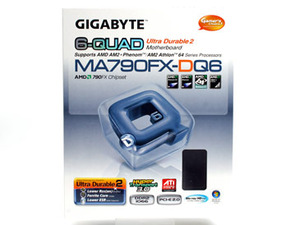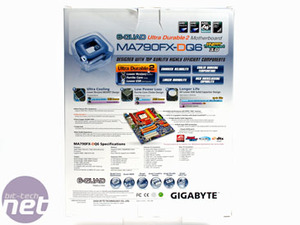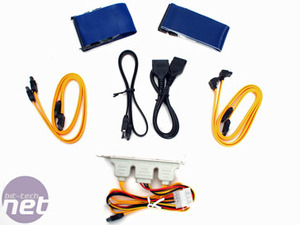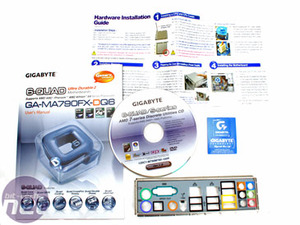Gigabyte MA790FX-DQ6
Manufacturer: GigabyteUK Price (as reviewed): £155.04 (inc. VAT)
US Price (as reviewed): $259.99 (ex. Tax)
AMD’s latest flagship chipset—the 790FX—launched a short while ago as part of the company's new "Spider" platform. The north bridge, which goes by the same name as the chipset as a whole, boasts latest features like 42 PCI-Express 2.0 lanes (32 for graphics) and HyperTransport 3.0 to connect AM2+ CPUs and AMD boasts an impressive 10W Thermal Design Power.
The second part of the 790FX chipset is nothing particularly new – it's the classic SB600 south bridge, which has been around since May 2006. It offers just four SATA, ten USB 2.0 ports and four first-generation PCI-Express lanes of its own. These are used as the interconnect between the north and south bridges, which means there's a 2GB/sec data transfer rate between the two chips – the same data rate used by Intel's latest chipsets.
The 790FX chipset is aimed at the enthusiast end of the market sporting either two x16 lanes or four x8s for CrossFireX. Believe it or not, it's the first chipset for AMD CPUs in the last year that is worth taking seriously – we're not counting nForce 680a SLI as a chipset worth taking seriously, since AMD has said it has effectively discontinued development on the Quad FX platform and from what we've heard, miniscule numbers of 680a boards (and chipsets) were sold.
Gigabyte's MA790FX-DQ6 is the first board we received based on AMD's new chipset, so let's find out if it ticks all the boxes required for it to live up to the reputation of previous DQ6 motherboards...
Gigabyte MA790FX-DQ6 Features
- Support for AMD Athlon 64, Athlon 64 X2, Athlon 64 FX, Sempron AM2 processors and AMD Phenom AM2+ processors
- HyperTransport bus speed: 4,000MT/s (HT3.0) or 2,000MT/s (HT2.0)
- North bridge: AMD 790FX
- South bridge: AMD SB600
- Four 1.8V DDR2 1,066/800/667MHz memory modules supporting up to 16GB of system memory
- Four PCI-Express 2.0 x16 ports (two x16 or four x8)
- One PCI-Express 1.0 x1 slot
- Six SATA 3Gbps ports and two eSATA ports
- Ten USB 2.0 ports
- Three 32-bit v2.3 Master PCI bus slots (support 3.3v/5v PCI bus interface)
- Realtek ALC889a 7.1 channel High-Definition audio codec with support for DTS Neo:PC and optical/RCA digital S/PDIF in and out
- Texas Instruments TSB43AB22A IEEE1394a PCI Firewire controller
- Two PCI-Express x1 Gigabit Ethernet controllers provided by the Realtek RTL8111B chipset
Box Contents
- Four orange SATA 3Gbps cables, two with 90 degree connectors
- One eSATA to SATA cable
- One Molex extension cable
- One blue IDE cable
- One blue floppy cable
- One PCI bracket with two eSATA ports and one molex socket
- Metal rear I/O bracket
- Manual, Quick Reference guide and drivers and utility CD
I like the four 90 degree SATA cables, even though there are six sockets on the board – the ends also finally include little clips which we've had for some time on the straight connectors. The 90 degree ends have to be used on the hard drive (and are appropriately labelled so) because the sockets on the motherboard face each other. This means you can easily unclip them but you can't use the 90 degree ends on the board.
There's the usual Gigabyte eSATA bracket that we've become accustomed to, but there's also two eSATA ports hardwired to the board – this doesn't really make much sense. Don't get me wrong, I love the fact it allows you to use normal hard drives externally, but where's my PCI bracket to use the four USB pin-outs? You're more likely to need extra USB than four eSATA ports.

MSI MPG Velox 100R Chassis Review
October 14 2021 | 15:04













Want to comment? Please log in.